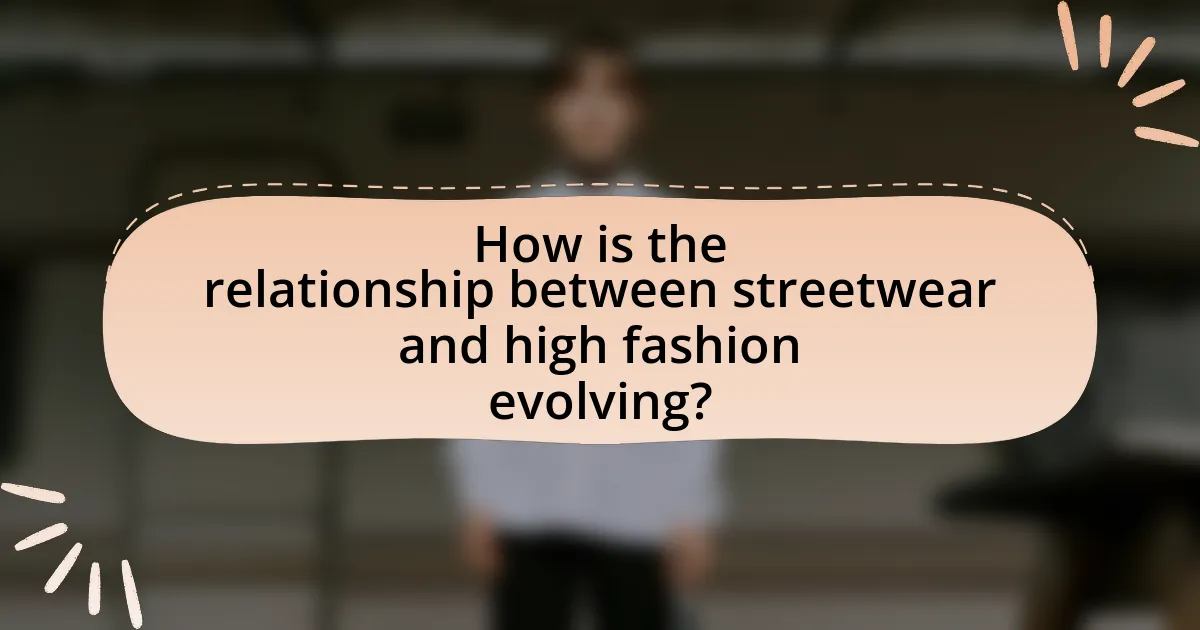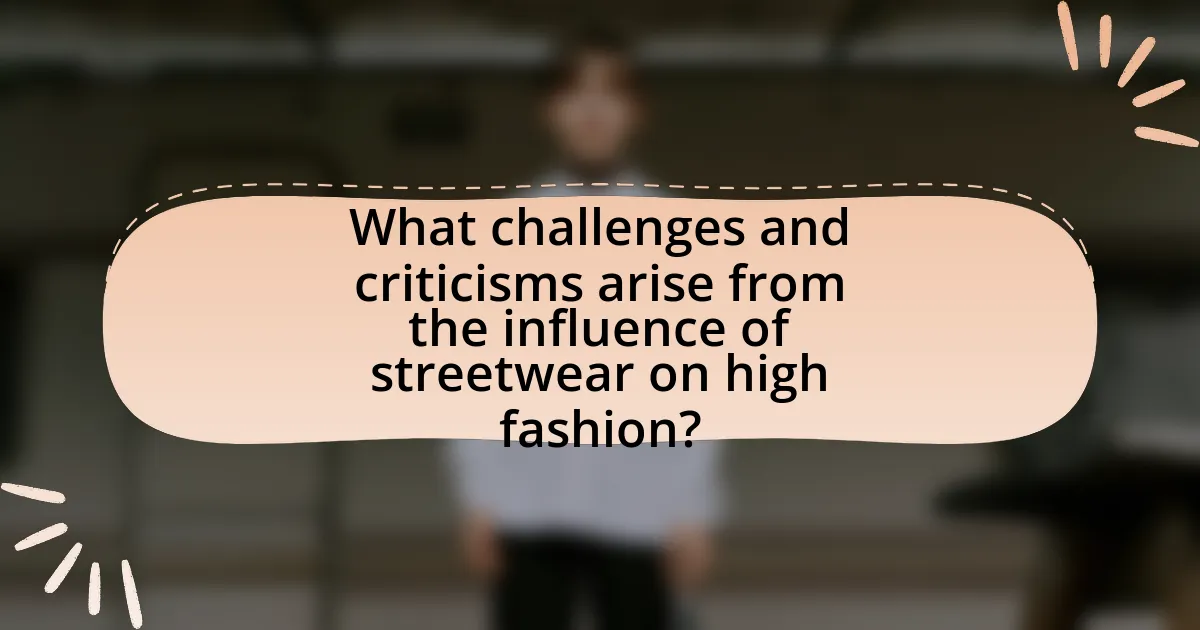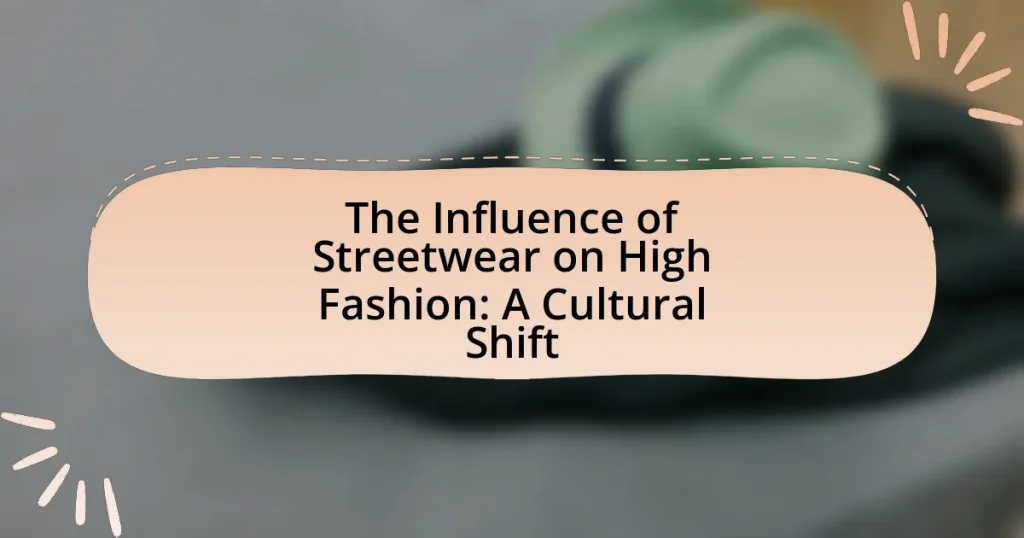The article examines the significant influence of streetwear on high fashion, highlighting how casual aesthetics, street culture, and inclusivity have reshaped luxury design. It discusses key collaborations, such as those between Supreme and Louis Vuitton, and the role of designers like Virgil Abloh in integrating streetwear elements into high fashion. The piece also explores cultural factors contributing to the rise of streetwear, its impact on consumer perceptions, and the challenges of commercialization and authenticity within this evolving landscape. Additionally, it addresses how fashion weeks and events reflect this cultural shift, emphasizing the importance of maintaining brand identity while appealing to a broader audience.

What is the Influence of Streetwear on High Fashion?
Streetwear has significantly influenced high fashion by introducing casual aesthetics, street culture, and inclusivity into luxury design. This shift is evident in collaborations between streetwear brands and high-end fashion houses, such as the partnership between Supreme and Louis Vuitton in 2017, which generated over $20 million in sales and showcased the blending of street culture with luxury branding. Additionally, high fashion designers like Virgil Abloh, who founded Off-White and later became the artistic director of Louis Vuitton menswear, have further integrated streetwear elements, emphasizing comfort and urban style. This cultural shift has democratized fashion, making it more accessible and reflective of diverse social movements, thus reshaping consumer expectations and industry standards.
How has streetwear emerged as a significant force in high fashion?
Streetwear has emerged as a significant force in high fashion by blending casual aesthetics with luxury branding, fundamentally altering consumer perceptions and market dynamics. This shift began in the late 20th century, with brands like Supreme and Off-White gaining traction, leading to collaborations with established luxury houses such as Louis Vuitton and Gucci. These partnerships have validated streetwear’s place in high fashion, evidenced by the $1 billion valuation of Supreme in 2017 and the high resale values of limited-edition streetwear items. The rise of social media has further amplified this trend, allowing streetwear culture to reach a global audience and influence fashion trends across demographics.
What cultural factors contributed to the rise of streetwear?
The rise of streetwear is primarily attributed to the influence of youth culture, urbanization, and the blending of various subcultures. Youth culture, particularly in the 1980s and 1990s, embraced casual and expressive clothing as a form of identity, leading to the popularity of brands like Supreme and Stüssy. Urbanization played a significant role as cities became melting pots of diverse cultural influences, allowing streetwear to draw from skate, hip-hop, and punk aesthetics. Additionally, the rise of social media and digital platforms facilitated the rapid dissemination of streetwear trends, enabling brands to reach a global audience and solidify their cultural relevance.
How do streetwear brands differ from traditional high fashion labels?
Streetwear brands differ from traditional high fashion labels primarily in their approach to design, target audience, and cultural relevance. Streetwear emphasizes casual, urban aesthetics and often incorporates elements from youth culture, music, and art, making it more accessible and relatable to a broader demographic. In contrast, traditional high fashion labels focus on exclusivity, craftsmanship, and luxury, often targeting affluent consumers and presenting collections through formal runway shows.
For instance, brands like Supreme and Off-White utilize limited releases and collaborations to create hype and community engagement, while high fashion houses like Chanel and Gucci maintain a more structured and elitist approach to branding and marketing. This distinction highlights the cultural shift where streetwear has influenced high fashion, leading to a blending of styles and a redefinition of luxury in contemporary fashion.
Why is the blending of streetwear and high fashion important?
The blending of streetwear and high fashion is important because it democratizes fashion, making it more accessible and reflective of diverse cultural influences. This fusion allows high fashion to tap into the authenticity and creativity of streetwear, which often originates from grassroots movements and urban environments. For instance, brands like Off-White and Balenciaga have successfully integrated streetwear aesthetics, leading to increased popularity and sales, as evidenced by a 2021 report from Business of Fashion that highlighted a 20% growth in luxury streetwear segments. This collaboration not only reshapes consumer perceptions but also drives innovation within the fashion industry, fostering a more inclusive and dynamic marketplace.
What impact does this blending have on consumer perceptions of fashion?
The blending of streetwear and high fashion significantly alters consumer perceptions by democratizing luxury and making it more accessible. This fusion challenges traditional notions of exclusivity, as high fashion brands incorporate casual, urban aesthetics, appealing to a broader audience. For instance, collaborations between brands like Off-White and Nike have led to increased visibility and desirability among younger consumers, who value authenticity and cultural relevance. As a result, consumers now associate high fashion with versatility and everyday wear, reshaping their expectations and preferences in the fashion industry.
How does this cultural shift reflect broader societal changes?
The cultural shift of streetwear influencing high fashion reflects broader societal changes by highlighting the democratization of fashion and the rise of individual expression. This shift indicates a move away from traditional fashion hierarchies, where luxury brands dictated trends, towards a more inclusive landscape where diverse voices and styles are celebrated. For instance, the collaboration between high-end brands like Gucci and streetwear labels demonstrates a blending of cultures that resonates with younger consumers who prioritize authenticity and personal identity over status. This trend aligns with the increasing value placed on social media influence, where platforms like Instagram amplify grassroots fashion movements, further illustrating how societal values are evolving towards inclusivity and self-expression.
What are the key characteristics of streetwear that influence high fashion?
The key characteristics of streetwear that influence high fashion include its emphasis on casual aesthetics, cultural relevance, and inclusivity. Casual aesthetics manifest through relaxed silhouettes and everyday wear, which challenge traditional high fashion norms that prioritize formal attire. Cultural relevance is evident as streetwear often draws inspiration from music, art, and social movements, making it a reflection of contemporary society. Inclusivity is highlighted by the accessibility of streetwear, appealing to diverse demographics and breaking down barriers in fashion. These characteristics have led high fashion brands to adopt streetwear elements, resulting in collaborations and collections that merge luxury with urban culture, as seen in partnerships like Louis Vuitton with Off-White.
How do streetwear aesthetics challenge traditional fashion norms?
Streetwear aesthetics challenge traditional fashion norms by prioritizing comfort, inclusivity, and self-expression over the exclusivity and formality typically associated with high fashion. This shift is evident in the use of casual materials, oversized silhouettes, and graphic designs that reflect urban culture, diverging from the tailored and often rigid structures of conventional fashion. The rise of streetwear brands like Supreme and Off-White has disrupted the fashion hierarchy, emphasizing accessibility and community engagement, which contrasts sharply with the elitism of traditional luxury brands. Furthermore, collaborations between streetwear labels and high-end designers, such as Louis Vuitton’s partnership with Virgil Abloh, illustrate how streetwear has infiltrated and redefined the luxury market, blurring the lines between casual and formal attire.
What role does authenticity play in the streetwear movement?
Authenticity is crucial in the streetwear movement as it establishes credibility and connection with the community. Streetwear brands often emphasize their roots in subcultures, such as skateboarding and hip-hop, which fosters a sense of belonging among consumers. For instance, brands like Supreme and Off-White have built their identities around limited releases and collaborations that reflect genuine cultural influences, reinforcing their authenticity. This commitment to authenticity not only attracts loyal customers but also differentiates these brands in a saturated market, as evidenced by Supreme’s resale value, which can exceed original retail prices by several times, highlighting the demand for authentic streetwear.

How is the relationship between streetwear and high fashion evolving?
The relationship between streetwear and high fashion is evolving towards greater integration and mutual influence. High fashion brands increasingly adopt streetwear aesthetics, as seen in collaborations like Louis Vuitton’s partnership with Off-White, which reflects a blending of luxury and casual styles. This shift is supported by the rise of social media, where streetwear culture thrives, allowing high fashion to reach younger audiences and adapt to contemporary trends. Additionally, the increasing acceptance of streetwear in luxury retail spaces indicates a significant cultural shift, with streetwear designers gaining recognition in prestigious fashion weeks and awards.
What collaborations exemplify the merging of streetwear and high fashion?
Collaborations that exemplify the merging of streetwear and high fashion include the partnership between Supreme and Louis Vuitton, which launched a collection in 2017 that combined streetwear aesthetics with luxury branding. This collaboration generated significant media attention and sales, highlighting the growing acceptance of streetwear in high fashion. Another notable example is the collaboration between Off-White and Nike, which redefined sneaker culture by blending high fashion design elements with athletic footwear, resulting in the highly sought-after “The Ten” collection. These collaborations demonstrate how streetwear has influenced high fashion, creating a cultural shift that blurs the lines between casual and luxury apparel.
How do these collaborations impact brand identity and consumer loyalty?
Collaborations between streetwear and high fashion significantly enhance brand identity and consumer loyalty by merging distinct cultural elements and appealing to diverse demographics. These partnerships often create a unique product offering that resonates with consumers’ values, such as authenticity and exclusivity, which strengthens brand identity. For instance, the collaboration between Nike and Off-White not only elevated Nike’s status in the luxury market but also attracted a younger, fashion-forward audience, thereby increasing consumer loyalty. Research indicates that brands engaging in collaborations can see a 20% increase in customer retention rates, as these partnerships foster a sense of community and belonging among consumers.
What are some notable examples of successful streetwear and high fashion partnerships?
Notable examples of successful streetwear and high fashion partnerships include the collaboration between Supreme and Louis Vuitton, which launched in 2017 and generated significant media attention and sales, with items selling out rapidly and reselling for high prices. Another example is the partnership between Off-White and Nike, which began in 2017 and featured the “The Ten” collection, blending streetwear aesthetics with high-performance sportswear, leading to widespread acclaim and high resale values. Additionally, the collaboration between Balenciaga and Adidas in 2021 showcased a fusion of luxury and streetwear, further solidifying the trend of high fashion embracing streetwear influences. These partnerships illustrate the growing intersection of streetwear and high fashion, reflecting a cultural shift in the fashion industry.
How do fashion weeks and events reflect this cultural shift?
Fashion weeks and events reflect the cultural shift towards streetwear by showcasing collections that blend high fashion with casual, urban aesthetics. Designers increasingly incorporate elements of streetwear, such as oversized silhouettes, graphic tees, and sneakers, into their runway presentations, signaling a departure from traditional luxury norms. For instance, brands like Off-White and Balenciaga have successfully merged streetwear influences with high fashion, demonstrating this trend’s acceptance and popularity. This shift is further evidenced by the growing presence of streetwear brands at prestigious fashion events, highlighting a broader cultural embrace of inclusivity and diversity in fashion.
What changes have been observed in runway presentations?
Runway presentations have increasingly incorporated streetwear elements, reflecting a cultural shift in high fashion. This change is evident in the blending of casual styles with traditional haute couture, as seen in collections from designers like Virgil Abloh and Demna Gvasalia, who have successfully merged luxury with everyday wear. Additionally, the use of diverse models and inclusive casting has become more prevalent, showcasing a broader representation of body types and ethnicities. This evolution in runway presentations signifies a departure from rigid fashion norms, embracing a more relaxed and accessible aesthetic that resonates with contemporary audiences.
How are streetwear brands represented in major fashion events?
Streetwear brands are prominently represented in major fashion events through collaborations with high-end designers, runway shows, and exclusive presentations. For instance, brands like Off-White and Supreme have showcased their collections at prestigious events such as Paris Fashion Week, highlighting their influence on contemporary fashion. The integration of streetwear aesthetics into luxury fashion has been evidenced by the participation of streetwear labels in collaborations with established fashion houses, such as the partnership between Louis Vuitton and Off-White’s Virgil Abloh, which marked a significant moment in the blending of streetwear with high fashion. This representation not only reflects the growing acceptance of streetwear in the luxury market but also signifies a cultural shift where streetwear is recognized as a legitimate and influential segment of the fashion industry.

What challenges and criticisms arise from the influence of streetwear on high fashion?
The influence of streetwear on high fashion presents challenges and criticisms primarily related to authenticity, exclusivity, and cultural appropriation. Critics argue that the blending of streetwear with high fashion often dilutes the artistic integrity and craftsmanship traditionally associated with luxury brands, leading to a perception of inauthenticity. For instance, high fashion brands adopting streetwear aesthetics may prioritize commercial appeal over genuine cultural representation, which can alienate original streetwear communities. Additionally, the rise of streetwear has sparked debates about cultural appropriation, as luxury brands sometimes borrow elements from marginalized cultures without proper acknowledgment or respect, raising ethical concerns. This dynamic creates tension between maintaining brand heritage and adapting to contemporary consumer preferences, ultimately challenging the established norms of the fashion industry.
What are the concerns regarding commercialization in streetwear?
Concerns regarding commercialization in streetwear include the dilution of authenticity and the potential loss of cultural significance. As brands prioritize profit, they may compromise the original values of streetwear, which often emphasize individuality and grassroots culture. This shift can lead to a homogenization of styles, where unique designs are replaced by mass-produced items that cater to mainstream trends. Additionally, the rise of fast fashion within the streetwear sector exacerbates environmental issues, as rapid production cycles contribute to waste and unsustainable practices. The commercialization also risks alienating the original community of enthusiasts, who may feel that the essence of streetwear is being exploited for profit rather than celebrated as a cultural movement.
How does mass production affect the authenticity of streetwear?
Mass production diminishes the authenticity of streetwear by prioritizing quantity over individuality. This shift leads to a homogenization of styles, where unique designs are replicated en masse, reducing the distinctiveness that originally characterized streetwear. For instance, brands like Supreme, which initially thrived on limited releases and exclusivity, face challenges as their designs become widely available through mass production, diluting their cultural significance. The rise of fast fashion has further exacerbated this issue, as companies quickly replicate streetwear trends, undermining the original creators and their artistic intent.
What criticisms do high fashion purists have about streetwear’s influence?
High fashion purists criticize streetwear’s influence for diluting the artistry and craftsmanship traditionally associated with luxury fashion. They argue that streetwear prioritizes commercial appeal and mass production over the meticulous design and quality that define high fashion. This perspective is supported by the observation that many streetwear brands focus on logo-centric designs and casual aesthetics, which high fashion purists believe undermines the sophistication and innovation that high fashion represents. Additionally, purists contend that the rise of streetwear has led to a homogenization of style, where unique cultural expressions are replaced by generic trends aimed at broader markets.
How can brands navigate the balance between streetwear and high fashion?
Brands can navigate the balance between streetwear and high fashion by integrating elements from both styles while maintaining their unique identity. This approach involves collaborating with streetwear designers to infuse casual aesthetics into luxury collections, as seen in partnerships like Louis Vuitton with Off-White’s Virgil Abloh, which successfully merged high fashion with street culture. Additionally, brands can adopt streetwear’s inclusive marketing strategies, appealing to a broader audience and leveraging social media platforms for engagement. This strategy is supported by the growing trend of high fashion brands incorporating streetwear elements, evidenced by the rise in popularity of luxury sneakers and casual wear in runway shows, reflecting consumer demand for versatility and comfort.
What strategies can brands employ to maintain authenticity while appealing to a broader audience?
Brands can maintain authenticity while appealing to a broader audience by prioritizing transparency, engaging with their community, and staying true to their core values. Transparency involves openly sharing the brand’s story, production processes, and ethical practices, which fosters trust among consumers. Engaging with the community through social media and collaborations allows brands to connect with diverse audiences while remaining grounded in their original identity. Additionally, staying true to core values ensures that the brand’s messaging and products resonate with its foundational principles, preventing dilution of authenticity. For instance, brands like Supreme have successfully expanded their reach while maintaining their streetwear roots by collaborating with high-fashion designers, thus appealing to a wider audience without compromising their identity.
How can brands effectively communicate their identity in this evolving landscape?
Brands can effectively communicate their identity in this evolving landscape by leveraging authenticity, engaging storytelling, and strategic collaborations. Authenticity resonates with consumers, as 86% of them prefer brands that are genuine and transparent, according to a study by Stackla. Engaging storytelling allows brands to connect emotionally with their audience, fostering loyalty and trust. Additionally, strategic collaborations with streetwear designers can enhance brand visibility and relevance, as seen with luxury brands like Gucci and Balenciaga, which have successfully integrated streetwear elements into their collections. This approach not only reflects current cultural trends but also positions brands as innovative and adaptable in a rapidly changing market.
What practical tips can brands consider when integrating streetwear into high fashion?
Brands should focus on collaboration with established streetwear designers to effectively integrate streetwear into high fashion. Collaborations allow high fashion brands to tap into the authenticity and cultural relevance of streetwear, attracting a younger demographic. For instance, the partnership between Louis Vuitton and Off-White’s Virgil Abloh successfully merged luxury with street culture, resulting in a collection that resonated with both markets. Additionally, brands should prioritize limited-edition releases to create exclusivity, as seen with Supreme’s drops, which generate hype and demand. Incorporating streetwear aesthetics, such as oversized silhouettes and graphic designs, into high fashion collections can also bridge the gap, making luxury more accessible and relatable.




